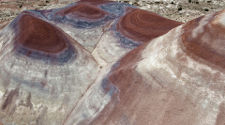
Some engineered barrier system (EBS) designs for the geological disposal of high-level radioactive waste include a bentonite (swelling clay) buffer and steel waste containers/overpack. One potentially deleterious process that may occur in the buffer is the alteration of swelling clay to iron-rich minerals, some of which have a limited capacity to swell. In recent years Quintessa have worked with Japan Atomic Energy Agency (JAEA) to develop an improved understanding of iron-bentonite interactions.
The results of this work have recently been published as a paper in the scientific journal ‘Applied Geochemistry’. In this study, new thermodynamic models of iron-rich clay minerals are presented along with three fully-coupled reactive transport models of a steel-bentonite interface. The thermodynamic models show the importance of solute activities on the stability of different iron-rich clay mineral structures. Of particular note is the influence of dissolved silica activity on the relative stabilities of 1:1 (non-swelling) and 2:1 (swelling) clay minerals. The reactive-transport models show that the extent and nature of the alteration predicted by the models was found to be sensitive to model conceptualisation, especially the assumptions made surrounding steel corrosion processes and solute transport.